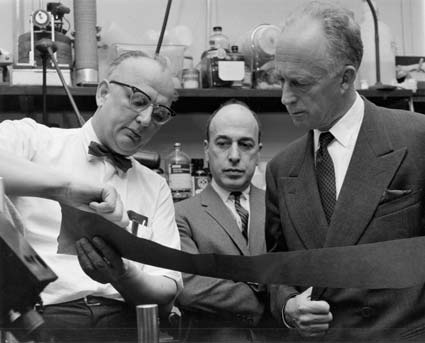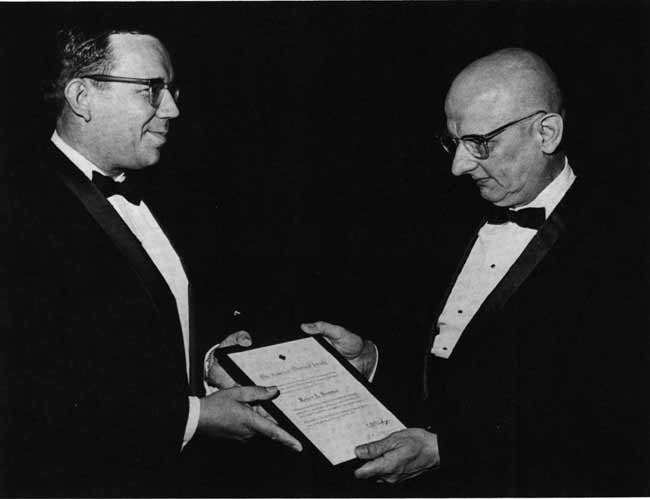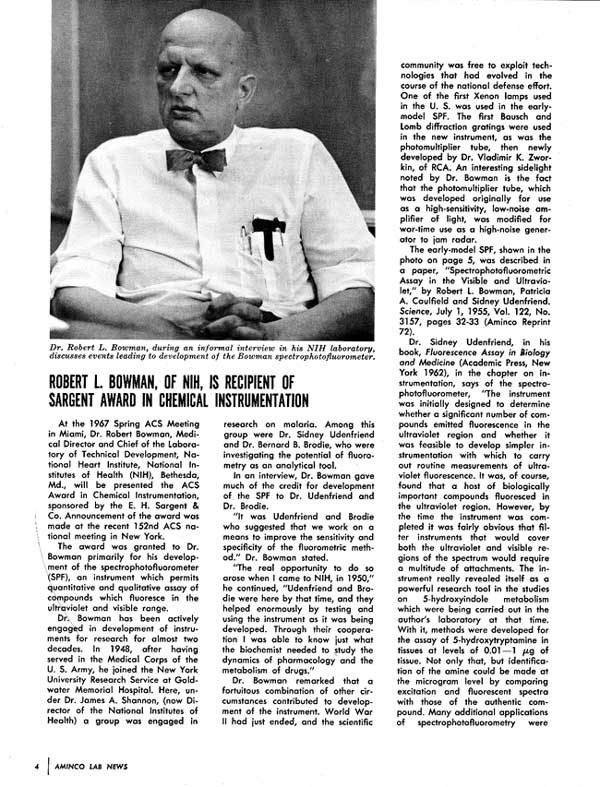Biographies
Julius Axelrod (1912-2004)
Julius "Julie" Axelrod won the Nobel Prize in 1970 for neurotransmitter research conducted in part with the spectrophotofluorometer (SPF). Dr. Axelrod was born in 1912 in New York City and attended the College of the City of New York. After graduation he worked as a lab assistant and a research chemist. He then moved on to Goldwater Memorial Hospital, where he worked as Dr. Brodie's lab technician for many years. In 1949 both Axelrod and Brodie joined the newly formed National Heart Institute (NHI) and while at NHI Axelrod earned his doctoral degree at George Washington University.
In 1955, after completing his doctoral work, Dr. Axelrod became chief of the Section on Pharmacology at the Laboratory of Clinical Science at the National Institute of Mental Health (NIMH) and began using the new SPF in his research on neurotransmitters. With the SPF, he was able to measure tiny amounts of neurotransmitters in the brain. He studied norepinephrine and described the process for storage, release, and "re-uptake" by the cells as needed. For this work, he was awarded the 1970 Nobel Prize in Physiology or Medicine. Dr. Axelrod formally retired from NIMH in 1984, though he continued to keep up a laboratory and be active in NIH research.
Dr. Julius Axelrod
Robert W. Berliner (1915-2002)
Robert Berliner was an eminent renal physiologist who was part of Dr. Shannon's group at Goldwater Memorial Hospital during World War II and came to NIH after the war. Dr. Berliner, born in New York City in 1915, earned his B.S. degree from Yale and his M.D. from Columbia in 1939. He served his medical school residency at Goldwater Memorial Hospital and moved to the National Heart Institute in 1950.
Dr. Berliner was chief of the Laboratory of Kidney and Electrolyte Metabolism at NHI for twelve years (1950-1962). He also served as the director for intramural research for that institute and in 1968 was named director of Laboratories and Clinics at NIH. He accepted an appointment as the first deputy director for science at NIH in 1969, a post he kept until he left NIH to become dean of the Yale University School of Medicine in 1973. Dr. Berliner, who studied the control of the excretion of sodium and potassium salts in the kidney, remained on the Yale faculty as an emeritus professor of cellular and molecular physiology until his death.
Robert Berliner (center) looks on as Robert Bowman (left) discusses his research with an AMINCO representative.
Robert L. Bowman (1916-1995)
Dr. Robert L. Bowman invented the practical spectrophotofluorometer (SPF). Born in New York City in 1916, Bowman tinkered with crystal radio sets, cameras, spare parts, and chemicals as a youth. He received his M.D. degree from the New York University College of Medicine in 1942 and went on to serve in the U.S. Army Medical Corps during World War II. After the war he returned to New York to work at Goldwater Memorial Hospital.
When James Shannon of Goldwater was named the head of the new National Heart Institute (NHI), Bowman-newly discharged from the Army-joined him and moved on to the Laboratory of Technical Development at the National Heart Institute. There he worked with Drs. Brodie, Berliner, Udenfriend, and others to develop the SPF.
Cover of Dr. Bowman's notebook
Select pages from Dr. Bowman's laboratory notebook
During his career at NHI, Dr. Bowman worked with other scientists to develop instruments that would help them do their research. Trained as a doctor and possessing a special knack for instrument manufacture, Dr. Bowman had an unusual mixture of talents and was honored with many awards including the 1967 American Chemical Society award in chemical instrumentation.
Dr. Bowman receiving the 1967 American Chemical Society award in chemical instrumentation
Bowman won the American Chemical Society Award in 1967





